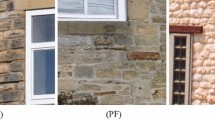Abstract
In the present paper, the elastic mechanical characteristics of masonry samples, whose texture is not visible due to plaster, are estimated by means of homogenization technique applied through thermographic images. In particular, three masonry samples with different textures have been purposely built. The chosen textures were periodic, quasi-periodic and random. The images, taken with a thermocamera, are analyzed in order to identify the texture. An homogenization technique, based on the application of appropriate boundary conditions, is used. The mechanical characteristics, obtained using the textures identified using photographic images and thermographic images, are compared. The influence of some parameters (such as the dimensions of the structural element used in morphological operator) are analyzed. The obtained results permit to point out the reliability of the masonry elastic characteristics assessment by the proposed procedure.










Similar content being viewed by others
References
Anthoine A (1995) Derivation of the in-plane elastic characteristics of masonry through homogenization theory. Int J Solids Struct 32:137–163
Lombardo M, Zeman J, Šejnoha M, Falsone G (2015) Stochastic modeling of chaotic masonry via mesostructural characterization. Int J Multiscale Comput Eng 7(2):171–185
Cavalagli N, Cluni F, Gusella V (2011) Strength domain of non-periodic masonry by homogenization in generalized plane state. Eur J Mech A Solid 30:113–126
Casolo S, Milani G (2013) Simplified out-of-plane modelling of three-leaf masonry walls accounting for the material texture. Constr Build Mater 40:330–351
Cecchi A, Sab K (2002) A multi-parameter homogenization study for modeling elastic masonry. Eur J Mech A Solid 21:249–268
Cluni F, Gusella V (2004) Homogenization of non-periodic masonry structures. Int J Solids Struct 41:1911–1923
Gusella V, Cluni F (2006) Random field and homogenization for masonry with nonperiodic microstructure. J Mech Mater Struct 1:357–386
Sab K, Nedjar B (2005) Periodization of random media and representative volume element size for linear composites. CR Mecanique 333:187–195
Šejnoha J, Šejnoha M, Zeman J, Sykora J, Vorel J (2008) Mesoscopic study on historic masonry. Struct Eng Mech 30:99–117
Zeman J, Šejnoha M (2007) From random microstructures to representative volume elements. Model Simul Mater Sci Eng 15(4):325–35
Cavalagli N, Cluni F, Gusella V (2013) Evaluation of a statistically equivalent periodic unit cell for a quasi-periodic masonry. Int J Solids Struct 50:4226–4240
Cavalagli N, Cluni F, Gusella V (2018) Failure surface of quasi-periodic masonry by means of statistically equivalent periodic unit cell approach. Meccanica 53:1719–1736
Cluni F, Gusella V (2014) Estimation of residuals for the homogenized solution: the case of the beam with random Young’s modulus. Probab Eng Mech 35:22–26
Cluni F, Gusella V (2018) Estimation of residuals for the homogenized solution of quasi-periodic media. Probab Eng Mech 54:110–117
Gusella F, Cluni F, Gusella V (2019) Homogenization of dynamic behaviour of heterogeneous beams with random Young’s modulus. Eur J Mech A Solid 73:260–267
Falsone G, Lombardo M (2009) Stochastic representation of the mechanical properties of irregular masonry structures. Int J Solids Struct 44:8600–8612
Milani G, Esquivel YW, Loureno PB, Riveiro B, Oliveira DV (2013) Characterization of the response of quasi-periodic masonry: geometrical investigation, homogenization and application to the Guimarães castle, Portugal. Eng Struct 56:621–641
Cluni F, Costarelli D, Minotti AM, Vinti G (2015) Enhancement of thermographic images as tool for structural analysis in earthquake engineering. NDT&E Int 70:60–72
Cluni F, Costarelli D, Minotti AM, Vinti G (2015) Applications of sampling Kantorovich operators to thermographic images for seismic engineering. J Comput Anal Appl 19:1–16
Hill R (1963) Elastic properties of reinforced solids: some theoretical principles. J Mech Phys Solids 11:357–372
Aboudi J (1991) Mechanics of composite materials: a unified micromechanical approach. Elsevier, Amsterdam
Huet C (1990) Application of variational concepts to size effects in elastic heterogeneous bodies. J Mech Phys Solids 38:813–841
MATLAB Image Processing Toolbox User's Guide (2008) The MathWorks Inc. Natick, MA, United States
Gonzales R, Woods R (2002) Digital image processing. Prentice-Hall, Upper Saddle River
Acknowledgements
The first two authors gratefully acknowledge the support received from the Italian Ministry of University and Research, through the PRIN 2015 funding scheme (Project 2015 JW9NJT—Advanced mechanical modelling of new materials and structures for the solution of 2020 Horizon challenges).The third author is a member of the "Gruppo Nazionale per l'Analisi Matematica, la Probabilità e le loro Applicazioni" (GNAMPA) of the "Istituto Nazionale di Alta Matematica" (INdAM) and has been partially supported by the projects "Ricerca di Base" 2017 and 2018 of Univ. of Perugia and N. 2017.0273.021 of Fond. Cassa di Risparmio di Perugia (Coord. G. Vinti). The authors thank the Company Edilsellano S.n.c. for the support relative to the building of the masonry walls.
Author information
Authors and Affiliations
Corresponding author
Ethics declarations
Conflict of interest
The authors declare that they have no conflict of interest.
Additional information
Publisher's Note
Springer Nature remains neutral with regard to jurisdictional claims in published maps and institutional affiliations.
Rights and permissions
About this article
Cite this article
Cluni, F., Gusella, V. & Vinti, G. Masonry elastic characteristics assessment by thermographic images. Meccanica 54, 1339–1349 (2019). https://doi.org/10.1007/s11012-019-00982-9
Received:
Accepted:
Published:
Issue Date:
DOI: https://doi.org/10.1007/s11012-019-00982-9




